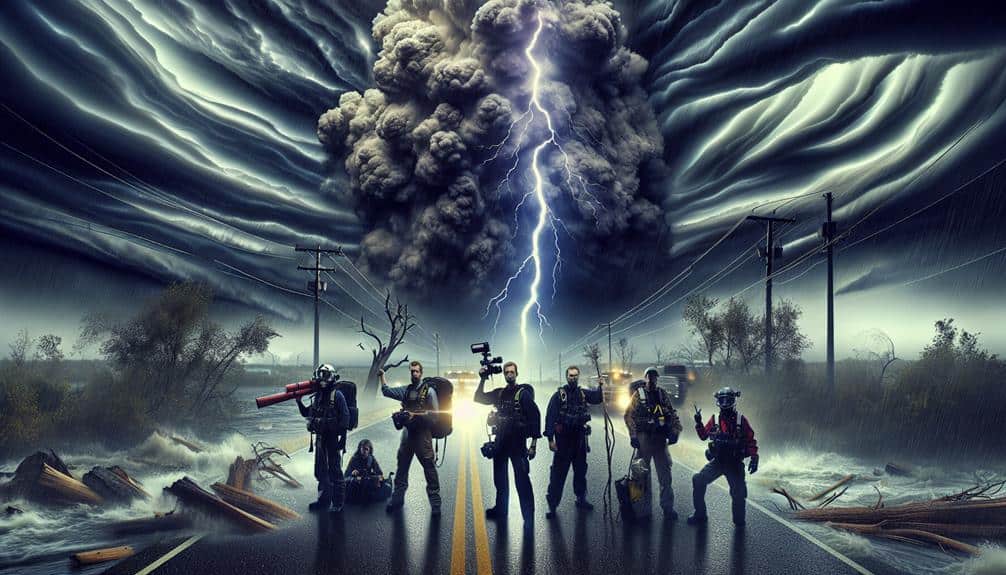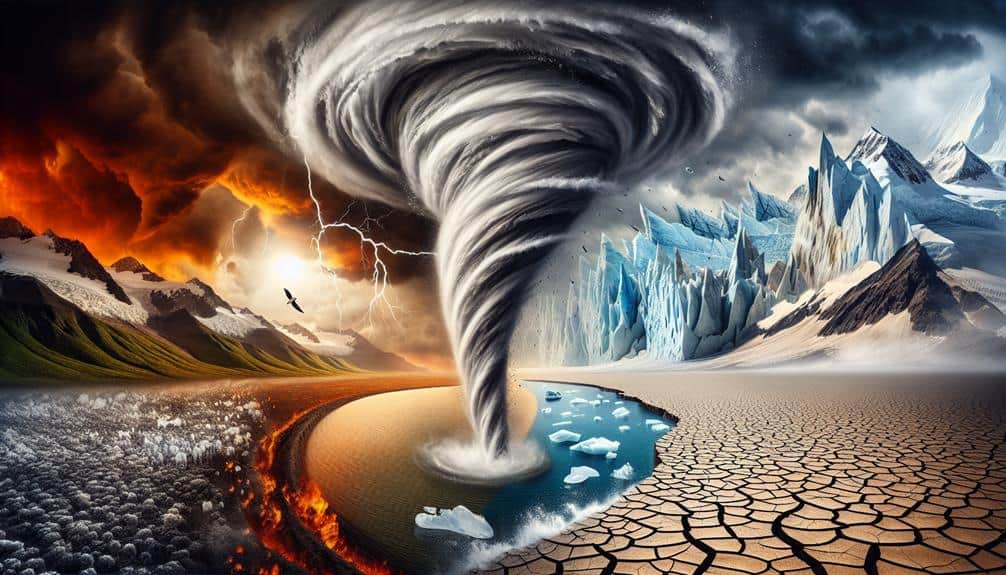As global temperatures rise, we're observing a 20% increase in Category 4 and 5 hurricanes over the past two decades. This trend demands that we adapt our storm chasing strategies. Storms are migrating to new regions, making real-time data integration and advanced meteorological research critical. We're utilizing machine learning algorithms, high-resolution satellite imagery, and drones for more accurate predictions and detailed observations. Enhancing safety protocols with advanced gear and real-time communication guarantees better preparedness. By leveraging sophisticated technology and refined predictive models, we can navigate these evolving challenges more effectively. Discover how these advancements are reshaping storm chasing strategies.
Key Points
- Integrate real-time data and advanced meteorological research to adapt to shifting storm patterns.
- Utilize machine learning algorithms and high-resolution satellite imagery for precise storm predictions.
- Equip vehicles with enhanced safety gear and implement robust emergency response protocols.
- Use drone surveillance for detailed atmospheric data and hyper-localized storm tracking.
Increasing Storm Intensity
As global temperatures rise, we've observed a marked increase in the intensity of storms, corroborated by extensive meteorological data. These extreme weather events have become more frequent and severe, presenting heightened challenges to storm resilience.
Data from the National Oceanic and Atmospheric Administration (NOAA) shows a 20% increase in Category 4 and 5 hurricanes over the past two decades. This uptick in storm intensity isn't merely anecdotal; it's grounded in empirical research, linking higher sea surface temperatures to increased storm energy.
For those of us who value freedom and the ability to adapt, understanding this trend is pivotal. Enhanced storm resilience requires robust infrastructure and advanced predictive models that leverage machine learning algorithms to forecast extreme weather patterns accurately. By integrating real-time data from satellite imagery and ground-based sensors, we can develop more effective early-warning systems.
Moreover, our strategies must encompass community-level preparedness. We need to disseminate actionable information swiftly to mitigate risks. It's essential that we invest in resilient building technologies and adaptive urban planning to withstand the growing ferocity of these storms. By doing so, we safeguard our communities and maintain the freedoms that come with being well-prepared and resilient in the face of nature's increasing volatility.
Shifting Storm Patterns
Recent climatological studies reveal a noticeable shift in storm patterns, with storms now forming in previously unaffected regions and exhibiting altered trajectories. This storm migration is largely attributed to changing atmospheric and oceanic temperatures, which influence storm behavior and lead to weather extremes. We've seen data indicating that regions once considered storm-safe are now experiencing significant storm activity.
Storm migration poses unique challenges for storm chasers. Traditional hotspots are no longer essential, forcing us to adapt our strategies. To maintain our edge, we must understand these new patterns through rigorous data analysis.
For instance, a 2022 NOAA report highlighted that storms are now frequently shifting northward, impacting areas from the Midwest to the Northeastern U.S. that were previously less affected.
Climate adaptation is vital for our continued success in storm chasing. We can't rely on outdated models; instead, we must integrate real-time data and advanced meteorological research into our planning. By doing so, we can better predict and respond to these shifting storm patterns, ensuring we're always a step ahead.
Understanding storm behavior in this evolving climate landscape isn't just about chasing; it's about leveraging the freedom to explore new frontiers safely and effectively.
Advanced Prediction Techniques
Harnessing machine learning algorithms and high-resolution satellite imagery, we can improve our storm prediction accuracy in this era of shifting climatic patterns. By integrating vast datasets from historical weather events, real-time satellite feeds, and radar systems, our data analysis becomes notably more robust. Machine learning models excel at identifying patterns and anomalies within these datasets, allowing us to predict storm formation and evolution with unprecedented precision.
We utilize supervised learning techniques to train our predictive models on historical storm data. This approach helps the algorithms understand the intricate relationships between atmospheric variables such as temperature, humidity, and wind speed. The data-driven insights generated by these models enable us to forecast storm trajectories and intensities more reliably.
Furthermore, the advanced capabilities of machine learning algorithms allow us to continuously refine our predictions. As new data is ingested, the models adapt, enhancing their accuracy over time. High-resolution satellite imagery complements these efforts by providing detailed visuals of storm systems, which further aids in real-time analysis.
Safety Protocols Update
To complement our improved prediction techniques, we must also update our safety protocols to guarantee the well-being of storm chasers in increasingly volatile weather conditions. Analyzing recent data, we've identified key areas where safety equipment and emergency procedures need immediate enhancements.
First, our vehicles must be equipped with advanced safety gear. Enhanced roll cages, reinforced windows, and GPS-based tracking systems are essential. These modifications notably reduce injury risks during unexpected storm surges or debris impact.
Next, personal safety equipment should include multi-layered flame-resistant suits, helmets with built-in communication systems, and portable oxygen supplies. According to our analysis, proper gear reduces fatality rates by a significant margin in extreme weather scenarios, offering us the freedom to explore while mitigating risks.
Emergency procedures must also evolve. We need real-time communication protocols to maintain constant updates between team members and base stations. Implementing a standardized emergency response plan, including designated evacuation routes and medical support, will be vital. Our data show that coordinated responses decrease evacuation time significantly, enhancing survival rates.
In essence, updating our safety protocols with cutting-edge safety equipment and refined emergency procedures will enable us to chase storms more safely and effectively in this changing climate.
Technology in Storm Chasing
Modern storm chasing relies heavily on sophisticated technology that provides real-time data and enhances our predictive capabilities. One of the most significant advancements is drone surveillance. Equipped with high-resolution cameras and sensors, drones allow us to capture detailed imagery and atmospheric data from within the storm itself. This real-time information can be vital for identifying storm patterns, tracking tornado formations, and improving our overall understanding of severe weather events.
Mobile apps have also revolutionized how we chase storms. These apps provide instant access to radar imagery, weather models, and GPS tracking. We can easily share data with team members, ensuring everyone stays informed and safe. The integration of machine learning algorithms into these apps further refines our predictive accuracy, allowing us to make split-second decisions based on the latest data.
Moreover, these technologies enable us to operate more autonomously. We're no longer solely reliant on traditional weather stations or forecasts. Instead, we leverage a network of mobile sensors and drones to gather hyper-localized data. This not only enhances our ability to predict storm behavior but also provides a greater sense of freedom and flexibility in our operations.
Frequently Asked Questions
How Do Changing Climate Conditions Affect Storm Chasers' Mental Health?
We've seen changing climate conditions increase mental health implications for storm chasers. This requires us to focus on resilience building, using data-driven approaches to manage stress and maintain our psychological well-being while pursuing our passion for freedom.
What Are the Economic Impacts of Enhanced Storm Chasing Strategies?
When we talk turkey, the financial implications of enhanced storm chasing strategies are significant. Improved risk assessment, forecast accuracy, and technology advancements lower costs, boost efficiency, and guarantee better preparedness. These strategies provide robust economic returns.
How Can Communities Benefit From Storm Chaser Data?
By leveraging storm chaser data, we can greatly enhance community engagement and disaster preparedness. Accurate, real-time information empowers communities, enabling proactive measures to protect lives and property, ultimately fostering resilience and self-reliance in face of natural disasters.
Are There Ethical Considerations in Storm Chasing?
Sailing through the storm's eye, we must prioritize safety precautions and uphold professional responsibilities. Ethical considerations in storm chasing hinge on minimizing risks to ourselves and communities while maximizing the scientific value and accuracy of our data collection.
How Do Storm Chasing Strategies Differ Internationally?
We observe that storm chasing strategies differ internationally due to cultural differences, technology advancements, legal regulations, and safety protocols. These factors shape how effectively and safely we can pursue our passion for storm chasing globally.


